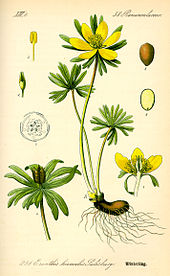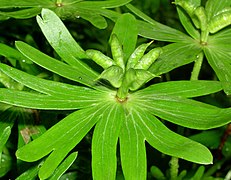Winterlings
| Winterlings | ||||||||||||
|---|---|---|---|---|---|---|---|---|---|---|---|---|

Winterling ( Eranthis hyemalis ) |
||||||||||||
| Systematics | ||||||||||||
|
||||||||||||
| Scientific name | ||||||||||||
| Eranthis | ||||||||||||
| Salisb. |
Winterlings ( Winterling ) ( Eranthis sp. ) Form a genus of plants in the buttercup family (Ranunculaceae) with about seven species. They occur in Eurasia .
description
Vegetative characteristics

Winterlings grow as perennial, herbaceous plants . They form a rhizome with a diameter of about 1 cm and several bulbous segments as a permanent organ. For Eranthis hyemalis , exact investigations showed that a hypocotyl bulb is formed. There are at most one or two basal leaves ; they consist of a long petiole and a palm-shaped leaf blade with an irregularly serrated leaf margin.
Generative characteristics
The inflorescence stem is always unbranched and ends in a terminal, single flower. Under the flower there is a whorl of horizontal bracts in a number that varies depending on the species. The flower is hermaphroditic and radial symmetry. The organs of the flower form five to eight yellow, white or pink-red, corolla-like sepals that are elongated, elliptical or egg-shaped. There are five to eight small and tubular nectaries , sometimes with sterile anthers. There are ten to many (up to 36) stamens with one-nerved, narrow linear stamens and ellipsoidal or circular anthers. There are four to nine, rarely more, free carpels per flower , which end in a clearly recognizable scar. Each carpel contains six to nine ovules . There are four to nine, rarely more follicles , which are 2 to 3 mm long, straight or curved in the upper area, end in a beak and each contain many seeds. The somewhat flattened, egg-shaped to ellipsoidal seeds have an olive-brown, smooth or network-like sculptured surface. The basic chromosome number is x = 8. All parts of the plant are poisonous.
Bracts and flower of Eranthis pinnatifida
Systematics and distribution
The genus Eranthis occurs in Eurasia and was first described in 1807 by Richard Anthony Salisbury with the type species Eranthis hyemalis . The generic name Eranthis is derived from the Greek words he for spring and anthos for blossom. A synonym for Eranthis Salisb. is Cammarum Hill nom. rej. The genus Eranthis belongs to the tribe Actaeeae in the subfamily Ranunculoideae within the family Ranunculaceae . The genus Eranthis is divided into two sections with eight and nine species:
| Surname | Common name | distribution | image |
|---|---|---|---|
| Section Eranthis: | |||
| Eranthis hyemalis (L.) Salisb. ( Winterling ) | (Syn .: Eranthis × tubergenii Hoog ( Eranthis cilicica × Eranthis hyemalis )): |
Southern Europe, it serves as an ornamental plant and occurs feral in Europe and North America. |

|
| Eranthis cilicica Schott & Kotschy | Turkey - South Anatolia |

|
|
| Eranthis longistipitata rule | Widespread in northeastern Iran and south-central Asia. |

|
|
|
Eranthis sect. Shibateranthis (Nakai) Tamura : It is used by some authors as a separate genus Shibateranthis Nakai separated |
|||
| Eranthis albiflora Franchet | Endemic to the western part of the Chinese province of Sichuan . | ||
| Eranthis lobulata W.T.Wang | Endemic to the north-central and western parts of the Chinese province of Sichuan. in the Qionglai Shan Mountains Tibet | ||
| Eranthis pinnatifida Maxim. | Japan - Middle and Western Honschu . |

|
|
| Eranthis sibirica DC. | Native to the mountains of Siberia. Altai , Angara area and Sayan mountains | ||
| Eranthis stellata Maxim. | In the Ussuri area, northern Korea and northeast China's Jilin and Liaoning provinces . | ||
| Eranthis byunsanensis B.Y. Sun | South Korea |
|
|
Web links to images:
- ↑ a b c Pictures of Eranthis species on Plantarium.ru (Latin + Russian).
- ↑ Pictures of E. albiflora on 2.bp.blogspot.com (English).
- ↑ Pictures from E. byunsanensis on kalle-k.dk (in English) ( Memento of the original from May 13, 2016 in the Internet Archive ) Info: The archive link has been inserted automatically and has not yet been checked. Please check the original and archive link according to the instructions and then remove this notice.
- ↑ Pictures by E. byunsanensis "kalle-k.dk" (English).
swell
- ↑ a b c d e f g Li Liangqian, Michio Tamura: Eranthis. In: Wu Zhengyi, Peter H. Raven, Deyuan Hong (Eds.): Flora of China . Volume 6: Caryophyllaceae through Lardizabalaceae . Science Press / Missouri Botanical Garden Press, Beijing / St. Louis 2001, ISBN 1-930723-05-9 , pp. 148 (English). ( flora.huh.harvard.edu PDF, efloras.org ).
- ↑ a b c d e Bruce D. Parfitt: Eranthis in Flora of North America Editorial Committee (Ed.): Flora of North America North of Mexico . Volume 3: Magnoliophyta: Magnoliidae and Hamamelidae . Oxford University Press, New York / Oxford a. a. 1997, ISBN 0-19-511246-6 , pp. 183-184 (English). ( efloras.org ).
- ↑ Wilhelm Troll: Comparative morphology of the higher plants. Part 1: organs of vegetation. Borntraeger, Berlin-Zehlendorf 1937–1943; Reprinted by Koeltz, Königstein 1967.
- ^ Theodor doctor: About the embryo formation of pseudomonocotyledons (Podophyllum Emodi and Eranthis hiemalis). Heinrich, Dresden 1933 (also dissertation, University of Göttingen 1929).
- ^ Richard Anthony Salisbury: Observations on the Genera of Trollius, Eranthis, Helleborus, Coptis, and Isopyrum. In: Transactions of the Linnean Society of London. Volume 8, 1807, pp. 300-307, here: p. 303, digitized .
- ^ Actaeeae in the Germplasm Resources Information Network (GRIN), USDA , ARS , National Genetic Resources Program. National Germplasm Resources Laboratory, Beltsville, Maryland.
- ↑ a b Michio Tamura: Eranthis. In: Adolf Engler, Karl Prantl (first), Paul Hiepko (ed.): The natural plant families along with their genera and more important species, especially useful plants. Volume 17a, part 4: Angiospermae: order Ranunculales, Fam. Ranunculaceae. 2nd greatly increased and improved edition. Duncker & Humblot, Berlin 1995, ISBN 3-428-07980-9 , pp. 253-255.
- ↑ Werner Greuter, Hervé-Maurice Burdet, Guy Long (eds.): Med-Checklist. A critical inventory of vascular plants of the circum-Mediterranean countries . Vol. 4: Dicotyledones (Lauraceae - Rhamnaceae) . Conservatoire et Jardin Botanique, Genève 1989, ISBN 2-8277-0154-5 , pp. 408 . ( bgbm.org ).
- ^ Peter Hadland Davis (ed.): Flora of Turkey and the East Aegean Islands. Vol. 1 (Pteridophyta to Polygalaceae) . Edinburgh University Press, Edinburgh 1965, ISBN 0-85224-159-3 , pp. 97 (reprinted 1997).
- ↑ Wen-Tsai Wang, Pei Gen Xiao: Acta Phytotaxonomica Sinica, Additamentum 1: 53, pl. 1, f. 1. 1965; ( tropicos.org )
- ↑ Megabook.ru (Russian); Весенник сибирский - Eranthis sibirica DC; megabook.ru
- ↑ BY Sun et al .: A New Species of Eranthis (Ranunculaceae) from Korea: E. byunsanensis. In: Korean Journal of Plant Taxonomy. Volume 23, No. 1, p. 23.
Web links
- Erik Wahlsteen: Descriptions and pictures of numerous Eranthis species. (English, the-genus-eranthis.blogspot.de )
- International Rock Gardener. No. 49 ISSN 2053-7557 , The Scottish Rock Garden Club, January 2014 (English, srgc.org.uk PDF).





